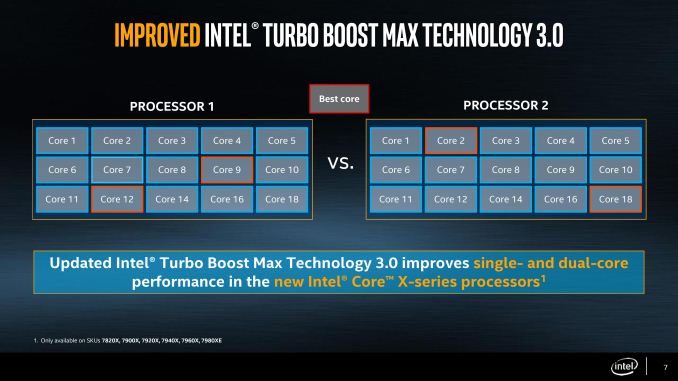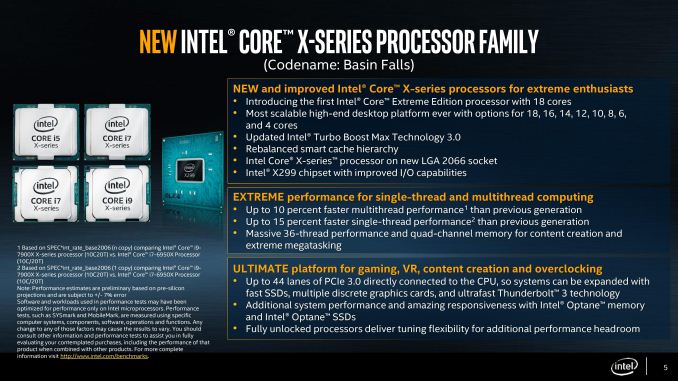Intel Announces Skylake-X: Bringing 18-Core HCC Silicon to Consumers for $1999
by Ian Cutress on May 30, 2017 3:03 AM ESTAnnouncement Four: AVX-512 & Favored Core
To complete the set, there are a couple of other points worth discussing. First up is that AVX-512 support coming to Skylake-X. Intel has implemented AVX-512 (or at least a variant of it) in the last generation of Xeon Phi processors, Knights Landing, but this will be the first implementation in a consumer/enterprise core.
Intel hasn’t given many details on AVX-512 yet, regarding whether there is one or two units per CPU, or if it is more granular and is per core. We expect it to be enabled on day one, although I have a suspicion there may be a BIOS flag that needs enabling in order to use it.
As with AVX and AVX2, the goal here is so provide a powerful set of hardware to solve vector calculations. The silicon that does this is dense, so sustained calculations run hot: we’ve seen processors that support AVX and AVX2 offer decreased operating frequencies when these instructions come along, and AVX-512 will be no different. Intel has not clarified at what frequency the AVX-512 instructions will run at, although if each core can support AVX-512 we suspect that the reduced frequency will only effect that core.
With the support of AVX-512, Intel is calling the Core i9-7980X ‘the first TeraFLOP CPU’. I’ve asked details as to how this figure is calculated (software, or theoretical), but it does make a milestone in processor design. We are muddying the waters a bit here though: an AVX unit does vector calculations, as does a GPU. We’re talking about parallel compute processes completed by dedicated hardware – the line between general purpose CPU and anything else is getting blurred.
Favored Core
For Broadwell-E, the last generation of Intel’s HEDT platform, we were introduced to the term ‘Favored Core’, which was given the title of Turbo Boost Max 3.0. The idea here is that each piece of silicon that comes off of the production line is different (which is then binned to match to a SKU), but within a piece of silicon the cores themselves will have different frequency and voltage characteristics. The one core that is determined to be the best is called the ‘Favored Core’, and when Intel’s Windows 10 driver and software were in place, single threaded workloads were moved to this favored core to run faster.
In theory, it was good – a step above the generic Turbo Boost 2.0 and offered an extra 100-200 MHz for single threaded applications. In practice, it was flawed: motherboard manufacturers didn’t support it, or they had it disabled in the BIOS by default. Users had to install the drivers and software as well – without the combination of all of these at work, the favored core feature didn’t work at all.
Intel is changing the feature for Skylake-X, with an upgrade and for ease-of-use. The driver and software are now part of Windows updates, so users will get them automatically (if you don’t want it, you have to disable it manually). With Skylake-X, instead of one core being the favored core, there are two cores in this family. As a result, two apps can be run at the higher frequency, or one app that needs two cores can participate.
Availability
Last but not least, let's talk about availability. Intel will likely announce availability during the keynote at Computex, which is going on at the same time as this news post goes live. The launch date should be sooner rather than later for the LCC parts, although the HCC parts are unknown. But no matter what, I think it's safe to say that by the end of this summer, we should expect a showdown over the best HEDT processor around.


















203 Comments
View All Comments
SaturnusDK - Thursday, June 1, 2017 - link
The infinity fabric seems to be working fine with minimal scaling performance loss for the Ryzen chips already on the market so there's no reason to believe that extending the bus will incur a severe performance penalty.rocky12345 - Thursday, June 1, 2017 - link
I got to ask Anandtech site gives all of this love to Intel for releasing products we already expected except for the 18/36 CPU (Thanks AMD for getting fire under Intel's butt again). What I am saying is there are at least three headlines for the Intel crap but one little byline for AMD's threadripper crap. I like Anandtech and all but AMD's release is way more important to the industry than this Intel release because of it were not for AMD new CPU line Intel would have just once more released a ho hum product with little extra to offer and probably $500 or more than the prices they are now asking. Give credit where credit is needed. You say new stuff in the industry does not excite you much anymore. Well for me and hopefully anyone else with a brain are more excited for the New AMD tech than this rehashed Intel tech. ThanksKalliMan - Friday, June 2, 2017 - link
There is a "small" mistake here. The price of 1800X is now ~ 429-449. You are comparing 2 CPUS with that belong to completely different price ranges( 1800X is 150- 170 $ cheaper than 7872X) . And be sure in Multitasking it will be superior.cekim - Friday, June 2, 2017 - link
To all those prattling on about how such processors have no market or purpose, I direct your attention to ebay... clearly you are wrong. The question is not whether there is a market for consumer HCC chips, the question is what that market is willing to pay for them?alpha754293 - Friday, June 2, 2017 - link
re: the whole AMD vs. Intel thing all over againI'm not worried about AMD as a threat at all.
Their latest processor, on some workloads, still barely beats an Intel Core i5(!) or can only beat some of the mid-range Core i7s at best.
I've long been an "AMD guy" because they used to be a value proposition - where you can get decent performance at a much lower price compared to the Intel counterparts.
But times have changed and that isn't really quite the case anymore. AMD CPUs really aren't that much cheaper compared to Intel's, but Intel's CPUs perform SIGNIFICANTLY better than AMD (mostly because AMD went the way of the UltraSPARC Niagara T1, by having only ONE FPU shared across multiple ALUs) - and of course, the problem with THAT design idea/approach is that fundamentally, CPUs are massively glorified calculators.
And AMD choose to cripple their product's ability to do calculations.
People have a tendency to want to focus on IPCs (as it is here). But really, you need both IPC AND FLOPs and a MUCH BETTER metric to compare against is FLOP/clock (because it tells you about the processor's computational efficiency), which almost NO one writes about anymore.
I'm already running 16 cores acrossed three systems and I just make the requisition for a 64-core system.
The "thing" that I have found/discovered with systems that have lots and lots of cores is that you REALLY WANT, should, and NEED to have ECC RAM because if you try to get it to do many things at once, in order to prevent issues with the programs interfering with each other, the ECC is a patch-style method that can help correct some of that.
When I've launched 6 runs of a computationally intensive task at once, some of them fail because my current systems don't have ECC Registered RAM (and I am not sure if the CPU knows what to do with it (being that the memory controller is on-die) and to deal with and work with memory coherency.
While it might be a welcome changed on the ultra high end, extreme enthusiast front, you can get a system that does a LOT more for a LOT less than what it would cost you to use these processors by using server grade hardware (albeit used - which, in my opinion, if it still works, why not? I don't see anything "wrong" with that.)
A system using the new 16-core CPU is likely going to run you between $3000-5000. The system that I just bought has 64 cores (four times more) with 512 GB of RAM for the same price.
Meteor2 - Saturday, June 3, 2017 - link
Literally TL;DR.Lolimaster - Saturday, June 3, 2017 - link
If you mean low threaded then you need to look at the Ryzen 5 1400-1500X which is 90% of the i7 7700 and its obviously "better" than the top of the line Ryzen at "some workloads, mean lower thread apps/games",$160-190, rip intel.
Gothmoth - Sunday, June 4, 2017 - link
so much words for trolling.... you took the time to write so much but when it comes to what you supposedly bought you suddenly become unspecific.... no letters and words to write it out you can only say "The system that I just bought ".twtech - Friday, June 2, 2017 - link
So what are some common applications for this many cores? Rendering, compiling large C++ projects like Unreal 4 for example. It may not be huge, but there is a market for more cores, and Intel doesn't want AMD taking all of it.slickr - Saturday, June 3, 2017 - link
So not only are they introducing less cores overall than AMD's threadripper at 32/64, they also cost a ton more money, require a new socket, it features locked overclocking and they cost more than AMD's equivalents.Intel really do have nothing, they announced their 14/16/18 cores, but they have no info on them, meaning it was a last minute thing, where they would only be available late 2017, but they have nothing else to go against AMD, so they are playing a move to trick people into thinking they have products up and coming soon, when they don't.